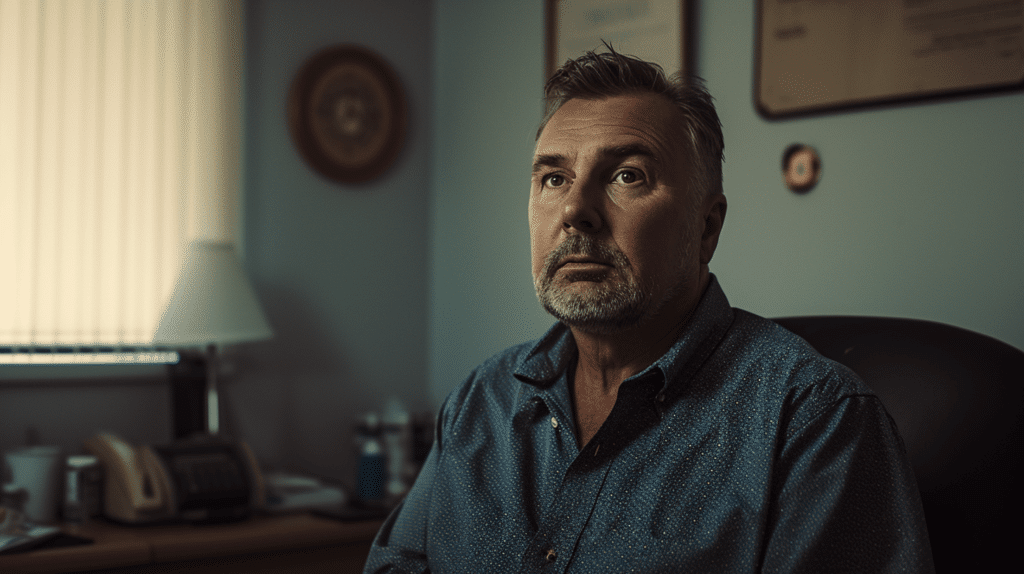
Identifying Low Testosterone Symptoms: Key Signs and Health Impacts
Low testosterone symptoms range from erectile dysfunction to chronic fatigue, and can impact your overall quality of life.
Are you experiencing fatigue, reduced libido, or muscle weakness? These are classic low testosterone symptoms, an issue that’s more common than many realize. This article delves into the signs of lowered testosterone, how they may affect your health, and what you might expect if you face this hormonal shift.
Key Takeaways
- Low testosterone symptoms range from decreased libido and erectile dysfunction to chronic fatigue and energy decline, impacting sexual health, relationships, mental health, and overall quality of life.
- Physical manifestations of low testosterone include a reduction in muscle mass, increased body fat, mainly around the abdomen, and changes in hair loss patterns, potentially affecting self-esteem and body image.
- Treatment options for low testosterone include lifestyle changes, medication, testosterone replacement therapy (TRT), and alternative therapies like enclomiphene.
- Proper diagnosis typically involves blood tests, and treatments must be tailored to individual needs, considering potential side effects.
Recognizing the Symptoms of Low Testosterone

Low testosterone, also known as testosterone deficiency, can manifest in a variety of ways. The symptoms may seem disparate, but they all hinge on the pivotal role that testosterone plays in the body. Identifying these symptoms is the initial significant move in managing one’s health and pursuing suitable treatment for testosterone deficiency syndrome.
Decreased Libido
A noticeable decrease in sex drive or libido is one of the most common symptoms of low testosterone. Testosterone is fundamental in prompting sexual desire and sustaining regular sexual function. As such, a significant dip in testosterone levels can lead to a waning interest in sexual activity, affecting personal relationships and mental health.
Erectile Difficulties
Erectile dysfunction is another prevalent symptom associated with low testosterone. Testosterone is indispensable in obtaining and preserving erections. It does this by stimulating the production of nitric oxide. This molecule triggers erections by relaxing the smooth muscle tissue in the penis and allowing for increased blood flow.
Therefore, low testosterone may contribute to frequent difficulties in achieving or sustaining an erection suitable for sexual intercourse.
Energy and Fatigue
Most people often overlook chronic fatigue and decreased energy levels as symptoms of low testosterone. Testosterone is involved in energy level regulation; a decrease in T levels can result in ongoing fatigue, regardless of adequate sleep or sleep apnea.
This decrease in energy can impact day-to-day activities and exercise regimens, leading to a reduced quality of life.
Physical Changes Resulting from Low Testosterone

Low testosterone doesn’t just affect one’s internal health; you can also see its effects on the body. From muscle mass reduction and increased body fat to changing hair loss patterns, these physical changes can significantly impact one’s self-esteem and body image perception.
Muscle Mass Reduction
Testosterone is vital in preserving muscle mass. It aids in the growth and strengthening of muscle fibers; hence, low testosterone levels can reduce muscle mass. This loss, in turn, can affect physical strength and overall body composition, posing challenges in maintaining an active lifestyle.
Increased Body Fat
Increased body fat, especially around the abdominal area, is also connected with low testosterone. The increased body fat is due to testosterone’s role in fat metabolism. As testosterone levels decline, the body’s ability to effectively metabolize fat can be impaired, leading to increased fat storage.
Hair Loss Patterns
Testosterone governs hair growth, with low levels potentially leading to hair loss, including male pattern baldness. While it’s important to note that hair loss can be influenced by various factors, including genetics and age, decreased testosterone levels can exacerbate the process.
Emotional and Cognitive Effects of Low Testosterone

Low testosterone’s effects are not limited to physical health but also affect emotional well-being and cognitive function. Mood fluctuations, memory issues, and cognitive decline are all linked to low testosterone levels, underscoring the hormone’s crucial role in mental health.
Mood Fluctuations
Testosterone’s influence on mood is significant. Studies show that low testosterone levels correlate with mood disorders such as depression and anxiety. Men with low testosterone may experience mood swings, increased irritability, and a decreased sense of well-being.
Therefore, tackling testosterone deficiency through testosterone therapy can be a vital move towards enhancing mental health, and opting for testosterone treatment can be an effective solution.
Memory and Cognitive Function
Testosterone also significantly influences cognitive functions, such as memory. Research suggests that low testosterone levels may contribute to cognitive decline and memory issues, with some studies indicating a higher risk of dementia in men with low testosterone.
Diagnosing and Treating Low Testosterone

Identifying the signs and symptoms of low testosterone paves the way for suitable management. However, it’s equally important to understand the diagnostic process for low testosterone and the available treatment options, which can range from:
- lifestyle changes
- dietary modifications
- exercise
- stress reduction techniques
- medication
- hormone replacement therapy
- enclomiphene
Blood Tests and Diagnosis
Blood tests, which assess the quantity of testosterone in the blood, are the standard diagnostic method to diagnose low testosterone. A single blood test is typically conducted in the morning, when testosterone levels are highest, and can help determine whether symptoms are due to low testosterone or another underlying condition.
Testosterone Replacement Therapy
TRT, also known as hormone therapy, is a standard treatment for low testosterone levels, providing relief for symptoms like fatigue and diminished libido. It helps to restore hormonal balance and improve the overall quality of life for many patients. This therapy replenishes testosterone levels, helping to alleviate symptoms and improve overall quality of life. However, it’s important to note that TRT may have potential side effects. Also, if you stop testosterone therapy, your testosterone levels generally revert to their original baseline numbers.
Enclomiphene
Enclomiphene is a relatively new treatment option for low testosterone. Unlike traditional TRT, which directly replaces testosterone, enclomiphene stimulates the body’s production of testosterone. It offers the benefit of fewer side effects. Unlike conventional TRT, it does not suppress sperm production, making it a good option for men who are concerned about fertility.
Lifestyle Factors Affecting Testosterone Levels
Though medical treatments can be beneficial, you should not overlook the influence of lifestyle factors on testosterone levels. Factors such as:
- Diet
- Exercise
- Stress
- Sleep
Various factors can affect testosterone production and, in turn, influence testosterone levels either positively or negatively.
Diet and Exercise
Maintaining optimal testosterone levels requires a healthy diet and consistent exercise. Exercise, in particular, can stimulate natural testosterone production, especially resistance and high-intensity interval training.
A balanced, nutritious diet can also support overall health, hormone production, and the regulation of luteinizing hormones.
Stress Management
Another critical aspect of maintaining healthy testosterone levels is effective stress management. Chronic stress can lead to hormonal imbalances, including a reduction in testosterone.
Effective stress management techniques, such as mindfulness and relaxation exercises, can help maintain balanced hormone levels, including follicle stimulating hormone, and promote overall well-being.
Underlying Causes of Low Testosterone
Though lifestyle factors can affect testosterone levels, one must also understand that underlying health conditions can result in low testosterone. We can broadly categorize these health conditions into primary and secondary causes, each affecting testosterone production differently.
Primary Hypogonadism
Primary hypogonadism stems from issues with the testicles, which produce testosterone. This disorder can result from conditions such as Klinefelter syndrome or treatments like chemotherapy, which can damage the testicles and impair their ability to produce testosterone.
Secondary Hypogonadism
Secondary hypogonadism, on the other hand, is caused by issues with the pituitary gland or hypothalamus, which controls the production of testosterone in the testicles. Conditions such as pituitary tumors or inflammatory diseases can interfere with these signals, leading to decreased testosterone production.
Summary
From decreased libido to changes in body composition, the effects of low testosterone can be far-reaching, impacting both physical and mental health. But the good news is that low testosterone is a treatable condition. Through lifestyle changes and medical treatments, it’s possible to manage symptoms and improve quality of life.
Recognizing the symptoms of low testosterone is the first step towards getting help. If you suspect you may have low testosterone, don’t hesitate to speak to a healthcare provider. With the correct diagnosis and treatment plan, you can control your health and return to feeling like your best self.
Frequently Asked Questions
If testosterone is low, it can lead to reduced erectile function, loss of body hair, less beard growth, and loss of lean muscle mass. It can also affect you emotionally, causing feelings of sadness or depression, trouble with memory and concentration, and lowered motivation and self-confidence. Treatment with testosterone therapy may help reduce these symptoms.
You can treat low testosterone by using skin gels, receiving intramuscular injections, taking enclomiphene, or using testosterone patches as directed. Additionally, incorporating aerobic and resistance training can help increase testosterone production and prevent common diseases like heart disease and cancer.
If you’re experiencing a reduction in sexual drive, difficulty maintaining an erection, hair loss, and fatigue, it could indicate low testosterone levels. Consulting a doctor to conduct tests like a serum testosterone test can help diagnose low testosterone.
Diet, exercise, stress, and sleep can all influence testosterone levels. Regular exercise and a healthy diet can help boost testosterone levels, while chronic stress and poor sleep can decrease them.
The main difference between primary and secondary hypogonadism is that primary hypogonadism stems from issues with the testicles. In contrast, secondary hypogonadism comes from problems with the pituitary gland or hypothalamus, which controls the production of testosterone in the testicles.
